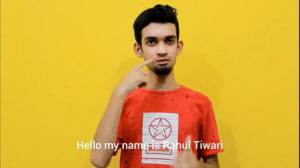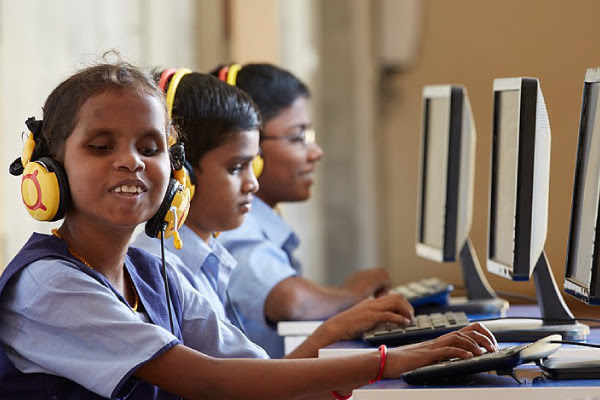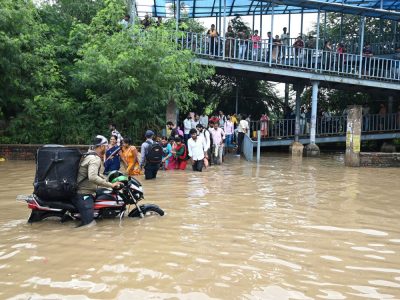For students with disabilities, the pandemic is nothing short of a nightmare. Here’s why
Rahul Tiwari is a 19- year-old deaf student from Banaras Hindu University pursuing BA (maths). Amid the pandemic, he is now unable to access online classes due to unavailability of a sign language interpreter. In a video message widely shared on social media he says in sign language “All classes have shifted online and there is no sign language interpretation available. I am sad, angry and worried about my future”.
Like Rahul, several other deaf students are facing difficulties accessing education. Anuj Jain, Executive Director, National Association of the Deaf(NAD) told Newz Hook, a news website dedicated for persons with disability, “The pandemic has affected the entire community. Many schools and universities shifted to online platforms for classes. However, deaf schools have done nothing about it. Students have been missing out on their education because of lack of accessibility.”
Rahul’s father took NAD’s help to access education for his kid, still he is facing difficulties despite belonging to an economically sound family. Thus, one can imagine the problems faced by poor kids with hearing impairments.
The online mode of education has left the majority of the students in dire straits. Several of them are unable to access education and those who are lucky are facing a host of other problems. A recent report by Swabhiman, a community-based organisation, and Disability Legislation Unit of Eastern India and partner of Centre for Advocacy and Research (CFAR) released to the media on July 23 titled “Digital Education in India: Will students with disabilities miss the bus?” says that 43 lakh may drop out as only 56.5% of students were “struggling yet attending classes”, that too irregularly.
In the report, 90% of parents of children with disabilities said that the teachers were not giving the attention required; 86% of children with disabilities do not know how to use technology. As many as 76% of mothers said they do not know about technology and are unable to assist their kids. And 81% of teachers do not have access to the education material that online mode of education requires.
Commenting on the report, Dr Sruti Mohapatra, CEO Swabhiman said, “All children with disabilities cannot be clubbed as one group as they are persons with different disabilities and therefore different needs. The current pandemic has the potential of leaving students with disability behind. If adequate measures are not taken urgently, they are likely to suffer irrecoverable losses in their quest for education and a life of dignity.”
Not only poor, those students who are lucky to have access to online education are facing multiple challenges. Atul (name changed), a student of Delhi University who has locomotor disability, told us, “I can’t move, can’t write easily. I can’t take classes sitting in one place. During tests I face difficulty in downloading question papers, then uploading and scanning them through phones, if no one is there to help me.”
Another report says that 56% of leading University websites don’t meet the accessibility parameters Web Contact Accessibility Guidelines WCAG 2.1, which includes several IITs, and central universities including JNU, AMU among many, creating more problems for students, pushing disabled students into a disadvantaged positions vis-a-vis their peers during this pandemic.

Muhammed Faisal Nawaz is a trainer at youth4jobs, an NGO which provides skill training for disabled youth, enabling them to acquire government employment.
Nawaz gives training to visually impaired students, who are worst affected due to this lockdown. Visually impaired students need to be escorted everytime, and they are not familiar with the online mode of education and now they are forced to take online education. The sudden lockdown didn’t allow training of trainers too. NGOs and universities providing training were not much familiar with how to provide training and education through distance mode. Now with this, everything has changed.
“I provide training for visually impaired students and when we started this online training, the biggest challenge was medium because many of them didn’t have gadgets. Some students are good at Braille but can’t handle gadgets. So with the help of the Blind Relief Association, I started giving training on conference calls through Zoom. But in Zoom too, there are a lot of limitations, ” says Nawaz.
Nawaz, who himself has childhood disabilities, thinks that Covid has made their life ever more challenging. He says, “I have had respiratory disability since childhood. If there are some students who have heart or respiratory disabilities, their oxygen saturation is less in their body, and they can’t talk much. Not just these, there are many students who have orthopedic disabilities like and require routine checkups in hospitals but can’t go. Even I couldn’t get my regular checkup because I can’t take the risk of going out. Second most difficulty is maintaining social distancing.”
A nationwide survey done by EVARA Foundation, Dashamlav and WeCapable has found that 75 % of people with disabilities are facing mental health issues like anxiety, depression and suicidal thoughts.

The study further reveals that 60% of them have zero income. Disabled people already have lower employability than normal students and since Covid this issue of employability has worsened, as disabled students have become more dependent on others for their day-to-day needs.
WHO in March said, “Certain populations, such as those with disability, may be impacted more significantly by Covid-19. This impact can be mitigated if appropriate actions and protective measures are taken by key stakeholders.”
Still, authorities in India couldn’t provide much help for them and their suffering keeps increasing.
According to the 2011 census, 2.2% — that is 26.8 million people — in India suffer from disability. Out of this, more than a fourth have movement-related and intellectual disabilities.
While disabled students are already fighting for accessibility to government buildings, highways, study materials — the pandemic has proved to be a nightmare for them.
(Cover: The online mode of education has left the majority of students with disabilities in dire straits // Credit: Giftabled.org)





